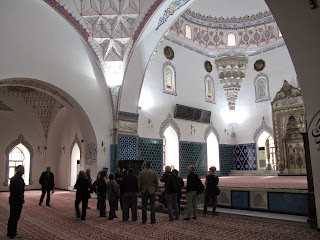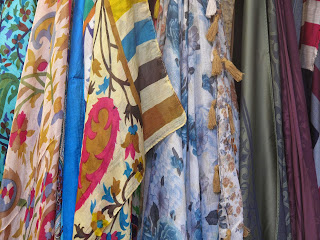“Haram! Namaz!”
[“Forbidden! Prayers!”] With these words a middle-aged woman shooed me
out of a side room at the Green Mosque (Yeşil Cami), one of the famous historic
mosques of early Ottoman Bursa. Women
had taken it over; tourists – especially non-Turkish, non-Muslim males – were
not welcome.
Inside the Mosque of Murat II
Bursa has swelled, with a population now well over 2
million. Traditionally it's called "Yeşil Bursa" ("Green Bursa"), for its trees, shrubs, flowers, but today, however flourishing its parks, it’s an industrial center featuring car manufacturing and food
processing (jams, juices, dairy) and no doubt much more, thanks to its location
close to the Sea of Marmara and not too far from Istanbul.
Fortunately, the historic kernel remains
pretty much as I remembered it: an east-west road on the lower slopes of an
impressive mountain, Uludağ (Olympos in antiquity, one of several of that
name), with Turkey’s premier ski resort on top.
Along that road one visits the Muradiye complex – the mosque of Murat II
and imperial tombs – at one end, the Green Mosque and Tomb (of Mehmet I Çelebi)
at the other end, with the tombs of Osman and Orhan, the first two Ottoman
sultans, and the Ulucami (the Grand Mosque) in the center, all of the
14th-early 15th centuries. One can even stroll on a street named for Halil İnalcık, the renowned historian of the Ottoman Empire (and professor at Bilkent University).
On the Saturday afternoon when we visited, part of a tour
group from Ankara, all these monuments were being enthusiastically visited – by
Turks, not foreigners. A large group of
head-covered (= pious) women swept in to venerate the tombs of Osman and
Orhan.
Hands came out, palms up, as
prayers were offered, as one does at burial sites. Curiously, the cenotaphs of Osman and Orhan
were flanked by a flag of the Turkish Republic (star and crescent on a red
background), as well as a green flag (Islamic/Ottoman, I imagine).
The cenotaph of Orhan, on the site of a Byzantine monastery (whose opus sectile pavement is still in place); the tomb was restored in the later 19th century, after the devastating earthquake of 1855.
I say curiously, because for one, I didn’t
remember these flags from previous visits, and secondly, the Republic had
brought the Ottoman Empire to an end. Do
you think Osman and Orhan would appreciate being saluted by the destroyers of
their family line?
But the AK Party, now in power, has made restoring
connection with the Ottoman Empire a point of prestige. Five roads leading into Ankara are now marked
by Ottoman-style arched gates. Each set
is slightly different from the others.
Each is extravagantly lit at night (unlikely to have happened even at
the end of the empire in the early 20th century). 
Ankara has also recently been graced by a series of clock
sculptures, designed to recall the clock towers erected during the reign of
Abdul Hamid II (late 19th-early 20th centuries). The new clock monuments are not as majestic
as their ancestors. Many look like wrist
watches, and not of the distinction of a Rolex.
Some are not even telling time correctly (the result of power outages,
perhaps?). Since no one depends on them
to tell time because we all have wrist watches or iPhones, this isn’t a grave
shortcoming.
Our mayor, Melih Gökçek, in power since 1994, well before
the AK Party began, has given us lots of underpasses (a truly Piranesian
network), waterfalls, and fake fortresses, in addition to the Ottomanesque entry
gates and clock/wrist watch monuments. Coming soon is a huge amusement park, on
low-lying ground below the hilltop where President Erdoğan’s vast 1000+ room palace
is located. For students of urban
planning, these developments must be highly perplexing – nothing to do with the
sociological or economic problems presented in the textbooks.
The tulips in Bursa were gorgeous, in large beds of
yellow and red, in parks by the historic mosques and in the Culture Park, a
large early Republican foundation in which the Archaeological Museum is
located. The museum was having
electricity problems. The lights were out in the main room, where the Classical
sculpture is on display, so we did our best with the natural light coming
through windows. Other rooms were fine,
though, including a room of pre-Classical finds and, elsewhere, a startling
reconstruction of a Phrygian wheeled cart, based on finds from a tumulus
burial.
Bursa is famous for İskender kebap, finely shaved slices
of lamb laid on flat bread, with a tomato
sauce and (if wished) melted butter, with a dollop of yogurt on the side. The name has nothing to do with Alexander the
Great (“İskender” in Turkish), but was the name of the restaurant owner in later
19th century Bursa who popularized this dish.
As you can imagine, iskender kebap was lunch for us that Saturday
afternoon (apart from the one vegetarian among us), and a heavy one at that, washed
down (if wished) by şıra, a traditional grape juice drink, very slightly
fermented.
How about a snack?
Bursa is also famous for silk and for thermal baths. Late afternoon, after the main monuments had
been visited, was given over to a tour of the Koza Han, a traditional building
for the silk business, now occupied almost exclusively by shops selling silk.
Interior courtyard, the Koza Han, on a Saturday afternoon
Featured were scarves, in much demand these days by women who cover their heads
(of course, a scarf can also be wrapped around the neck). Men’s ties, which I kept my eye out for, were
few and very, very drab (nothing to do with the colorful patterns for women’s
scarves).
Bursa has hot springs, so each traditional bath, or
hamam, has a hot pool, a very nice feature. I was already tired, having
just returned from a transatlantic trip two days before, and the relaxation
from the hot pool, the scrub, and the message nearly sent me into a Rip van
Winkle-like sleep. But I had to appear
for dinner, and for the tour to İznik the next day.











No comments:
Post a Comment